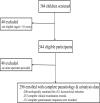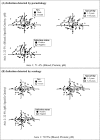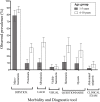Identifying and evaluating field indicators of urogenital schistosomiasis-related morbidity in preschool-aged children
- PMID: 25793584
- PMCID: PMC4368198
- DOI: 10.1371/journal.pntd.0003649
Identifying and evaluating field indicators of urogenital schistosomiasis-related morbidity in preschool-aged children
Abstract
Background: Several studies have been conducted quantifying the impact of schistosome infections on health and development in school-aged children. In contrast, relatively little is known about morbidity levels in preschool-aged children (≤ 5 years) who have been neglected in terms of schistosome research and control. The aim of this study was to compare the utility of available point-of-care (POC) morbidity diagnostic tools in preschool versus primary school-aged children (6-10 years) and determine markers which can be used in the field to identify and quantify Schistosoma haematobium-related morbidity.
Methods/principal findings: A comparative cross-sectional study was conducted to evaluate the performance of currently available POC morbidity diagnostic tools on Zimbabwean children aged 1-5 years (n=104) and 6-10 years (n=194). Morbidity was determined using the POC diagnostics questionnaire-based reporting of haematuria and dysuria, clinical examination, urinalysis by dipsticks, and urine albumin-to-creatinine ratio (UACR). Attributable fractions were used to quantify the proportion of morbidity attributable to S. haematobium infection. Based on results of attributable fractions, UACR was identified as the most reliable tool for detecting schistosome-related morbidity, followed by dipsticks, visual urine inspection, questionnaires, and lastly clinical examination. The results of urine dipstick attributes showed that proteinuria and microhaematuria accounted for most differences between schistosome egg-positive and negative children (T=-50.1; p<0.001). These observations were consistent in preschool vs. primary school-aged children.
Conclusions/significance: Preschool-aged children in endemic areas can be effectively screened for schistosome-related morbidity using the same currently available diagnostic tools applicable to older children. UACR for detecting albuminuria is recommended as the best choice for rapid assessment of morbidity attributed to S. haematobium infection in children in the field. The use of dipstick microhaematuria and proteinuria as additional indicators of schistosome-related morbidity would improve the estimation of disease burden in young children.
Conflict of interest statement
The authors have declared that no competing interests exist.
Figures




Similar articles
-
Urogenital schistosomiasis among pre-school and school aged children in four districts of north western Tanzania after 15 years of mass drug administration: Geographical prevalence, risk factors and performance of haematuria reagent strips.PLoS Negl Trop Dis. 2022 Oct 12;16(10):e0010834. doi: 10.1371/journal.pntd.0010834. eCollection 2022 Oct. PLoS Negl Trop Dis. 2022. PMID: 36223393 Free PMC article.
-
Assessment of urine metabolite biomarkers for the detection of S. haematobium infection in pre-school aged children in a rural community in Zimbabwe.Acta Trop. 2024 Oct;258:107327. doi: 10.1016/j.actatropica.2024.107327. Epub 2024 Aug 8. Acta Trop. 2024. PMID: 39127139
-
Six rounds of annual praziquantel treatment during a national helminth control program significantly reduced schistosome infection and morbidity levels in a cohort of schoolchildren in Zimbabwe.PLoS Negl Trop Dis. 2020 Jun 22;14(6):e0008388. doi: 10.1371/journal.pntd.0008388. eCollection 2020 Jun. PLoS Negl Trop Dis. 2020. PMID: 32569278 Free PMC article.
-
Meta-analysis of urine heme dipstick diagnosis of Schistosoma haematobium infection, including low-prevalence and previously-treated populations.PLoS Negl Trop Dis. 2013 Sep 12;7(9):e2431. doi: 10.1371/journal.pntd.0002431. eCollection 2013. PLoS Negl Trop Dis. 2013. PMID: 24069486 Free PMC article. Review.
-
Ultrasound aspects and risk factors associated with urogenital schistosomiasis among primary school children in Mali.Infect Dis Poverty. 2023 Apr 20;12(1):40. doi: 10.1186/s40249-023-01071-6. Infect Dis Poverty. 2023. PMID: 37081494 Free PMC article.
Cited by
-
Prevalence and morbidity of urogenital schistosomiasis among pre-school age children in Cubal, Angola.PLoS Negl Trop Dis. 2023 Nov 8;17(11):e0011751. doi: 10.1371/journal.pntd.0011751. eCollection 2023 Nov. PLoS Negl Trop Dis. 2023. PMID: 37939154 Free PMC article.
-
Expanding Praziquantel (PZQ) Access beyond Mass Drug Administration Programs: Paving a Way Forward for a Pediatric PZQ Formulation for Schistosomiasis.PLoS Negl Trop Dis. 2016 Sep 22;10(9):e0004946. doi: 10.1371/journal.pntd.0004946. eCollection 2016 Sep. PLoS Negl Trop Dis. 2016. PMID: 27658198 Free PMC article. No abstract available.
-
Evaluation of the Clinitek®, a point-of-care urinalysis system for the measurement of clinically significant urinary metabolites and detection of haematuria in Schistosoma haematobium infected children in southern Côte d'Ivoire.Parasit Vectors. 2019 Jun 13;12(1):298. doi: 10.1186/s13071-019-3555-z. Parasit Vectors. 2019. PMID: 31196145 Free PMC article.
-
A systematic review and meta-analysis quantifying schistosomiasis infection burden in pre-school aged children (PreSAC) in sub-Saharan Africa for the period 2000-2020.PLoS One. 2020 Dec 29;15(12):e0244695. doi: 10.1371/journal.pone.0244695. eCollection 2020. PLoS One. 2020. PMID: 33373405 Free PMC article.
-
Non-Traditional Risk Factors of Albuminuria in the Pediatric Population: A Scoping Review.Int J Environ Res Public Health. 2017 Oct 16;14(10):1231. doi: 10.3390/ijerph14101231. Int J Environ Res Public Health. 2017. PMID: 29035316 Free PMC article.
References
-
- World Health Organization. Working to overcome the global impact of neglected tropical diseases First WHO report on neglected tropical diseases. Geneva: World Health Organization; 2010. http://whqlibdoc.who.int/publications/2010/9789241564090_eng.pdf.
-
- Chen MG, Mott KE. Progress in assessment of morbidity due to Schistosoma haematobium infection. Trop Dis Bull. 1989;86: R1–R36.
-
- van der Werf MJ, de Vlas SJ. Diagnosis of urinary schistosomiasis: a novel approach to compare bladder pathology measured by ultrasound and three methods for hematuria detection. Am J Trop Med Hyg. 2004;71: 98–106. - PubMed
Publication types
MeSH terms
Substances
Grants and funding
LinkOut - more resources
Full Text Sources
Other Literature Sources
Medical

